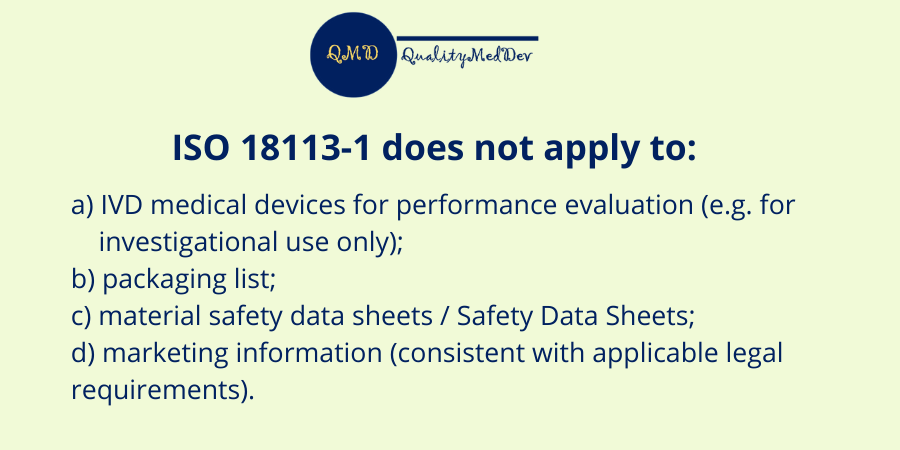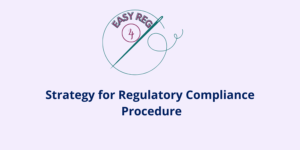ISO 18113 defines the requirements associated to labelling for In-Vitro Diagnostic Medical Devices. We have extensively discusse about labelling in several occasions within QualityMedDev website. For example in relation to labelling-related ISO standard such as ISO 15223 and ISO 20417 or related topics such eIFU and UDI management.
ISO 18113 consists of the following parts, under the general title In vitro diagnostic medical devices — Information supplied by the manufacturer (labelling):
- — Part 1: Terms, definitions and general requirements
- — Part 2: In vitro diagnostic reagents for professional use
- — Part 3: In vitro diagnostic instruments for professional use
- — Part 4: In vitro diagnostic reagents for self-testing
- — Part 5: In vitro diagnostic instruments for self-testing
In this Article we will mainly focused on Part-1, discussing in particular the general requirements associated to the labelling of IVD medical devices.
Before moving into the discussions associated to the contents of the standard, let’s spend few words about the specific scope of ISO 18113. In fact, within chapter 1 of the standard it is mentioned:
This document defines concepts, establishes general principles, and specifies essential requirements for information supplied by the manufacturer of IVD medical devices. This document does not address language requirements since that is the domain of national lows and regulations.
The standard defines as well what stands outside the scope of ISO 18113, that can be summirezed I the scheme below:

Few Important Definitions from ISO 18113
ISO 18113 Part-1 contains a huge number of definitions that obviously we will not be able to extensively discuss in this article. We are going however to report here below few important definitions that we considered significant to properly understand the regulatory requirements mentioned in this standard.
- Aid to Diagnosis IVD Medical Devices : aid to are used to provide additional information to assist in the determination or verification of a patient’s clinical status. The assay is not the sole determinant.
- biological reference interval reference interval : specified interval of the distribution of values taken from a biological reference population.
- Diagnostic IVD Medical Devices are used to determine, verify, or confirm a patient’s clinical condition as a sole determinant. This type of examination also includes sole confirmatory assays (to verify the results of previous testing) and sole exclusion assays (to rule out a particular condition). Specimen receptacles are also considered as in vitro diagnostic medical devices
- Examination : set of operations having the object of determining the value or characteristics of a property.
- Kit : a set of components that are packaged together and intended to be used to perform a specific in vitro diagnostic examination.
- Metrological Traceability: property of a measurement result whereby the result can be related to a reference through a documented unbroken chain of calibrations, each contributing to the measurement uncertainty.
- Performance Evaluation: assessment and analysis of data to establish or verify the scientific validity, the analytical and, where applicable, the clinical performance of an IVD medical device
General Requirements for Labelling of IVD Medical Devices according to ISO 18113
Section 4 of ISO 18113 defines the general requirements for labelling of IVD Medical Devices.
First, the standard specifies that format, content, location, and accessibility of information supplied by the manufacturer shall be appropriate to the particular device. This basically means that the specific intended use, education and training shall be taken in consideration. It is essential that IFU and other materials supplied by the manufacturer are written in such way they are properly understood by the user, taking as well in consideration the whole life time of the device. In fact, as specified in section 4.1.2, legibility of the information on labels and in the instructions for use is assessed as part of the design verification.
Another important point is related to section 4.1.6, stating that it is not possible to have in the labelling any language regarding the manufacturer’s liability in the case of damage or injury resulting from the use or malfunction of the specific IVD device that contradicts the applicable laws and regulations.
ISO 18113 mentions few requirements about the language of labelling. In fact, all the information supplied by the manufacturer have to be written in the official languages of the countries where the device it is distributed. The main exception is related of address and name of manufacturer, which do not need to be provided in multiple languages.
Requirements for the Instructions for Use
Instructions for use shall always be provided by the manufacturer unless, the risk analysis based on ISO 14971 shows that the device can be use safely without IFU. The release date and the revision of the IFU shall be properly identified, along with clear identification of any modifications performed.
IFU can also be supplied in non-paper format, taking in consideration the specific intended use of the device and all the applicable regulations; the type of medium used to provide the IFU shall be justified within risk management documentation.
Ian case the IFU are not provided with the device in paper form, the manufacturer shall design product and labelling in order to provide:
a) instructions on how to obtain the information;
b) access to the correct version of the instructions for use;
c) as a minimum, information to cover safe handling and storage prior to use.
Disclosure of Residual Risks
The last topic we want to briefly discuss is the relation between IFU and risk management and the necessity to disclose residual risks in the interactions for use, as specified within section 4.8 of ISO 18113. In fact, it is clearly mentioned that the user shall be informed about known safety hazard and the residual risks; in this context ISO 14971 and ISO 62366 applies.
Conclusions
In conclusion, we have been discussing the mai requirements associated to ISO 18113, related to information to be supplied by the manufacturer for In-Vitro Diagnostic Medical Devices. After having mentioned few key definition, we went through the specific requirements associated to the Instructions for Use, including the connection between IFU – Risk Management – Usability.
Subscribe to 4EasyReg Newsletter
4EasyReg is an online platform dedicated to Quality & Regulatory matters within the medical device industry. Have a look to all the services that we provide: we are very transparent in the pricing associated to these consulting services.
Within our WebShop, a wide range of procedures, templates, checklists are available, all of them focused on regulatory topics for medical device compliance to applicable regulations. Within the webshop, a dedicated section related to cybersecurity and compliance to ISO 27001 for medical device organizations is also present.
As one of the leading online platforms in the medical device sector, 4EasyReg offers extensive support for regulatory compliance. Our services cover a wide range of topics, from EU MDR & IVDR to ISO 13485, encompassing risk management, biocompatibility, usability, software verification and validation, and assistance in preparing technical documentation for MDR compliance.
Do not hesitate to subscribe to our Newsletter!

